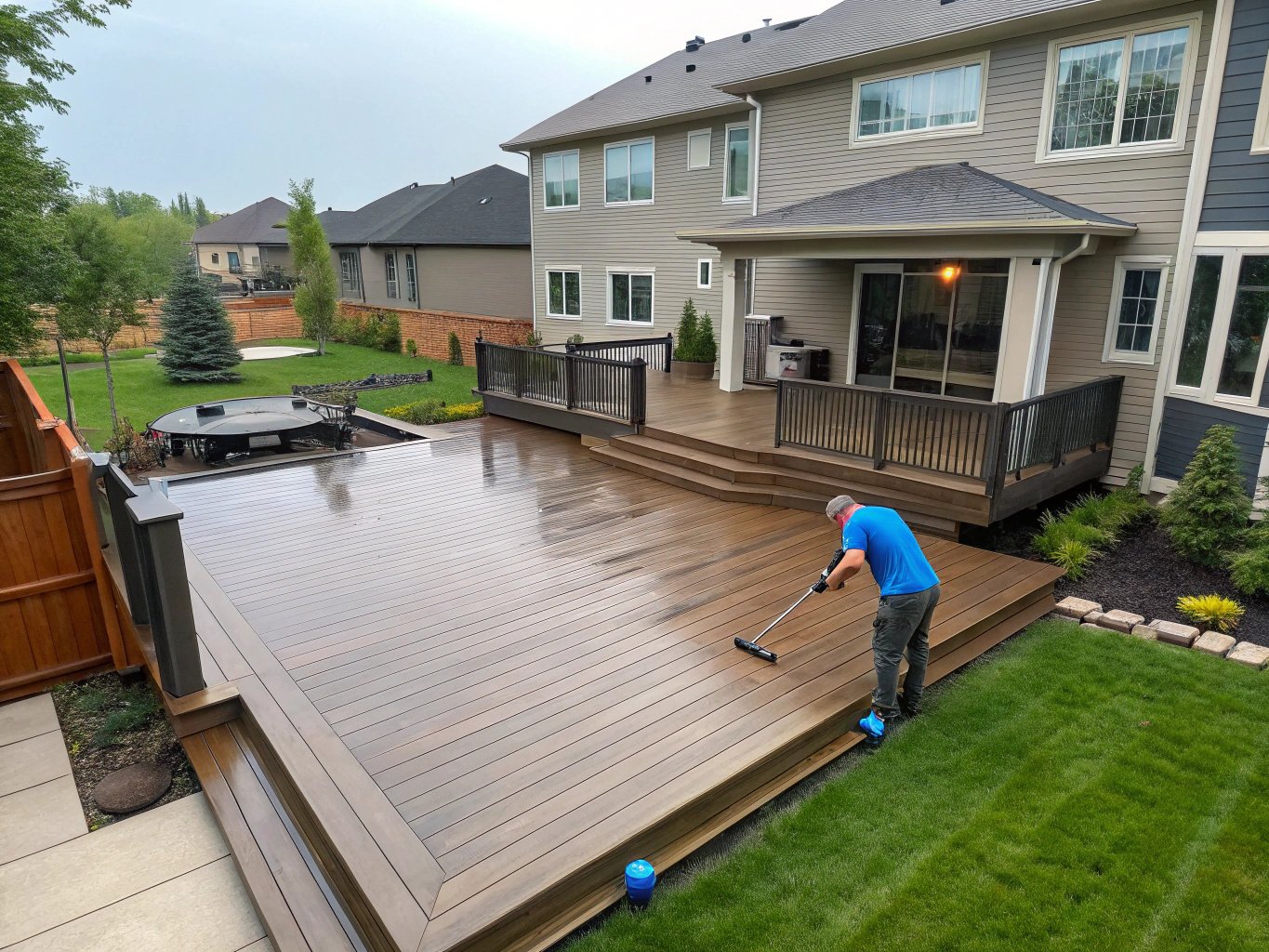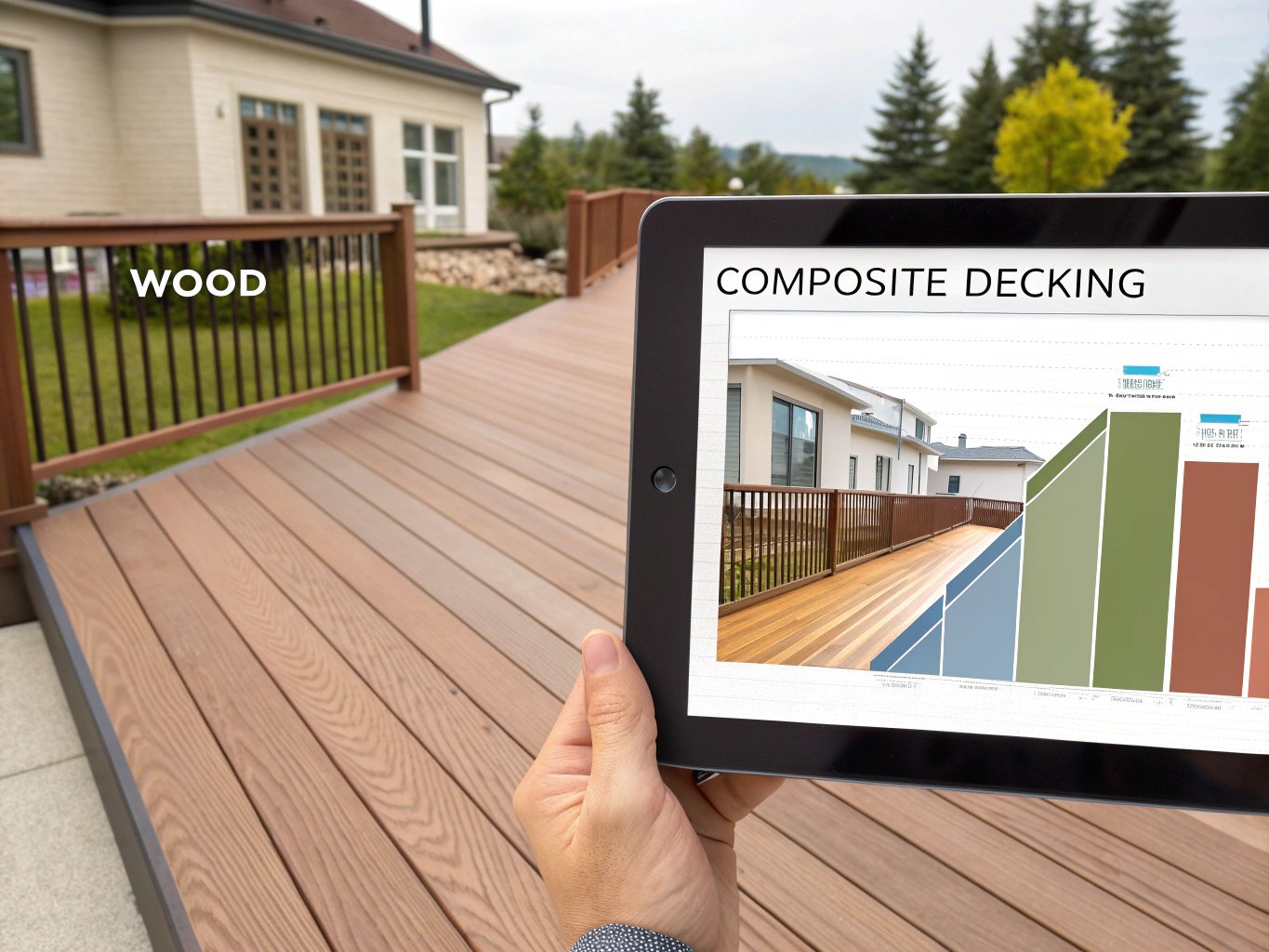
Is replacing your wood deck with composite decking worth the investment? Many homeowners are making the switch, but is it the right decision for you?
Transitioning from wood to composite decking offers substantial long-term benefits, such as significantly reduced maintenance requirements, superior durability, and a broad selection of aesthetic styles. These advantages make composite decking an ideal option for homeowners seeking a balance of practicality and design versatility.
Deciding to replace your traditional wood deck with composite decking can feel like a big step. Composite decking promises longevity and ease of maintenance, but is it truly the right choice for your home and budget? In this guide, we’ll explore why many homeowners are choosing composite over wood and help you determine whether it’s the best solution for your decking needs.
✔
Composite decking is low-maintenance, needing only occasional cleaning, whereas wood requires regular sealing, sanding, and staining to maintain its appearance.
✖
While wood can be strong, it is more susceptible to weathering, rot, and pests compared to composite decking, which is built for long-term durability.
Why Replace Your Wood Deck with Composite?
When you initially build a wood deck, it can feel like an investment that will last for years. However, over time, wood decks require constant maintenance—sanding, sealing, staining, and dealing with issues like rotting or splintering. The appeal of composite decking lies in its ability to offer the look and feel of wood, but without the ongoing upkeep.
Composite decking is made from a combination of wood fibers and plastic, which makes it resistant to the elements. This means no more sanding or staining your deck every few years. It’s designed to resist moisture, mildew, and pests that often plague traditional wood decks, making it a durable option for your outdoor space. The best part? Composite decking doesn’t fade or warp in the same way that wood does, maintaining its appearance for much longer.
Another reason why homeowners choose composite over wood is the variety of designs available. Composite decking comes in a range of colors, textures, and finishes that can replicate the natural beauty of wood, without the upkeep. Whether you’re building a modern, sleek patio or a rustic-looking deck, there’s a composite option that can fit your vision.
✔
Wood decking is generally more affordable to install initially, but long-term maintenance costs can make it more expensive than composite decking over time.
✖
Composite decking is engineered to resist warping, while wood is more vulnerable to moisture and temperature fluctuations that can cause warping and cracking.
Long-Term Benefits of Composite Decking

Composite decking’s primary appeal is its low-maintenance nature. Once installed, composite decks require very little upkeep. While wood decks need to be refinished every few years to maintain their appearance, composite decking only requires periodic cleaning with soap and water. This makes it a more convenient choice for those who want to enjoy their outdoor space without dedicating hours to maintenance.
In addition to maintenance benefits, composite decking is more durable. Wood decks are vulnerable to moisture, which can lead to rot and warping over time. Composite decking is engineered to resist moisture, preventing rot and extending the lifespan of the deck. This durability is especially beneficial in regions with fluctuating weather conditions or high humidity, where wood decks may degrade much faster.
Another major benefit is the safety composite decking offers. Many composite decks come with features like slip-resistant surfaces, making them safer in wet conditions. Wood decks, on the other hand, can become slippery when wet and may even develop splinters, which can be a hazard for children and pets.
✔
Composite decking is designed to absorb less heat, making it more comfortable for bare feet in hot weather compared to wood, which can become very hot under the sun.
✖
Wood decking can last for decades with proper care, but it requires regular maintenance. Composite decking generally lasts longer and is more resistant to harsh weather, reducing the need for frequent upkeep.
Cost Considerations: Is Composite Decking Worth It?

The initial cost of composite decking can be higher than wood, often by 30% or more. However, when you factor in the long-term cost savings from reduced maintenance, the investment becomes more worthwhile. Wood decks require constant attention to maintain their aesthetic appeal and structural integrity. Composite decking eliminates this issue, saving you money on staining, sealing, and repairs over time.
Moreover, composite decking lasts significantly longer than wood. A wood deck may last 10 to 15 years with regular maintenance, while composite decks can last 25 years or more, depending on the quality of the material. The extended lifespan means fewer repairs and replacements, which adds to its overall cost-effectiveness.
Another important factor is the resale value. While a wood deck may look attractive initially, potential buyers may be deterred by the amount of maintenance it requires. A composite deck, on the other hand, can be a strong selling point due to its durability, low maintenance, and modern appeal.
✖
While composite decking often has a higher initial cost, it can save money in the long run due to reduced maintenance and longer durability, making it a better overall investment.
✖
Even with proper care, wood decks typically don’t last as long as composite decks due to susceptibility to weathering, rot, and pests. Composite decking is more resistant to these issues, ensuring a longer lifespan.
Choosing the Right Composite Decking for Your Home

When choosing composite decking, it’s important to consider a few key factors: the quality of the materials, the warranty offered by the manufacturer, and the aesthetic options available. Not all composite decking is created equal, so it’s essential to invest in high-quality products that will provide the durability and look you want for your outdoor space.
Start by researching reputable brands known for their quality composite decking materials. Look for products with warranties of at least 25 years, as this indicates a high level of confidence in the decking’s longevity. Pay attention to the colors, textures, and finishes available to ensure the decking complements your home’s exterior design.
You should also consider the installation process. While composite decking is easier to maintain, the initial installation can be more involved than wood decking. Be sure to hire a qualified contractor or follow the manufacturer’s instructions carefully if you choose to install it yourself.
✔
Although professional installation can ensure the best results, composite decking can be installed by homeowners with the right tools and instructions, saving on labor costs.
❌
Most composite decking materials are designed to be durable and withstand environmental conditions. Selecting the right brand and material for your region minimizes issues, so poor choices don’t always lead to major problems.
Conclusion
Replacing your wood deck with composite decking is a smart decision for many homeowners, especially those who want to minimize maintenance and enhance the durability of their outdoor spaces. Composite decking offers long-term benefits like easy upkeep, strength against weathering, and a variety of design options. While the upfront cost may be higher, the overall value and savings in maintenance make composite decking a worthwhile investment in the long run. Whether you’re renovating your existing deck or building a new one, composite decking can provide the perfect solution for a beautiful and low-maintenance outdoor living space.
